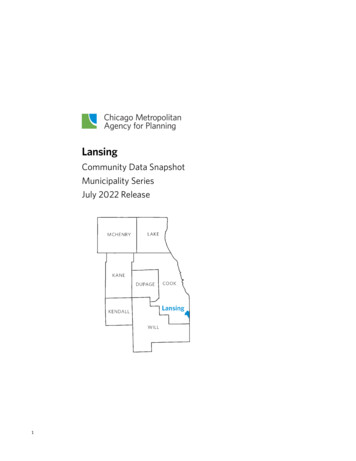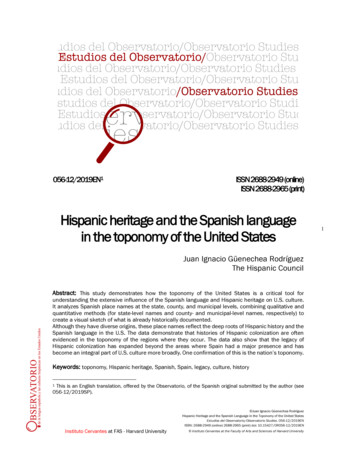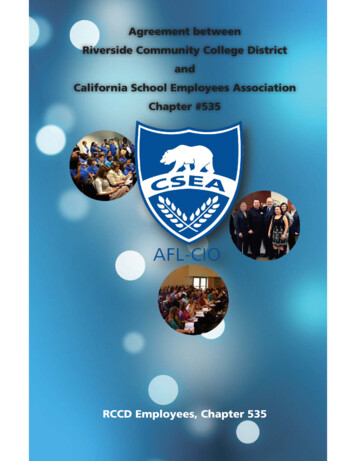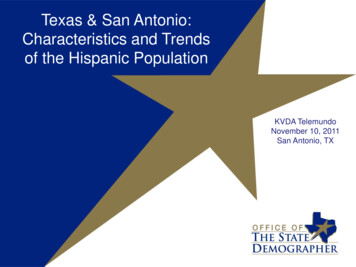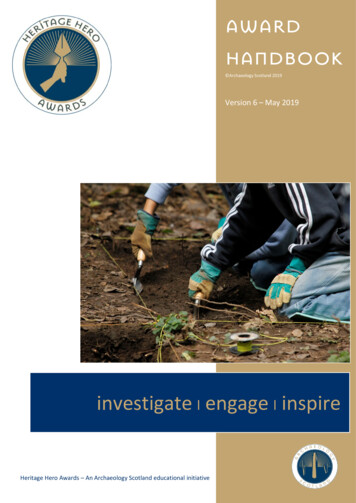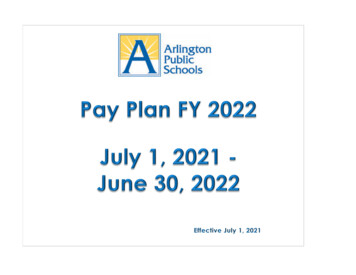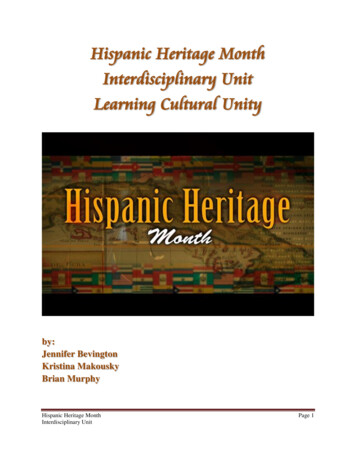
Transcription
Hispanic Heritage MonthInterdisciplinary UnitLearning Cultural Unityby:Jennifer BevingtonKristina MakouskyBrian MurphyHispanic Heritage MonthInterdisciplinary UnitPage 1
Table of ContentsIntroduction . 3Background. 3Overview. 3Unit Calendar. 4Letter to Parents. 5Art . 6Objectives . 6Classroom Approach . 8Assessment and Rubric. 9English . 13Objectives . 13Classroom Approach . 14Assessment and Rubric. 17Spanish . 20Objectives . 20Classroom Approach . 22Assessment and Rubric. 23Appendix. 25English Class Guest Speaker Alberto Monserrate Handout . 25English Class Sample Kids Discover Documentation . 26Artist of the Day Trading Cards . 27Spanish Class Sample Vocabulary Bingo . 28Spanish Class Jeopardy Input Screen . 29Spanish Class Guest Speaker Ramón León Handout . 30References . 31Hispanic Heritage MonthInterdisciplinary UnitPage 2
IntroductionBackgroundFrom its beginnings in the early years of the United States, the Hispanic community has played avital role in our nation and its culture. Hispanics are the fastest growing ethnic group in theUnited States at four times the national average since the year 2000. There are over 53 millionHispanics in the U.S., making it the second largest ethnic group in America and the largestSpanish speaking group outside of Mexico (Brown and Lopez, 2013).This interdisciplinary unit has been developed to introduce students to the Hispanic culture, theircontributions, and their history.OverviewGrade:8thClasses:Art, English, SpanishUnit:Hispanic Heritage MonthTiming:This is a two week unit that is to be completed between Sept. 15 and Oct.15 tocorrespond to Hispanic Heritage Month activities throughout the United States.Unit GIO: Students will understand of the important role that Hispanic Americans have playedin the culture and growth of the United States.Hispanic Heritage MonthInterdisciplinary UnitPage 3
Unit CalendarThis calendar shows the combined teaching and activities for each discipline. Items are listed ata high level. For detailed information go to each disciplines section below.Week OneMondayTuesdayWednesdayThursdayFridayArt –Includes an“Artist of theDay”EnglishHispanic Art:Introduction &Art JournalsSalvador DalíJournals: Focuson DrawingPablo PicassoJournal: Focuson CollagingJoaquín TorresGarcíaJournals: CoverArt FernandoBoteroEsperanzaRising wrap-upIntroducejournal project,assign countriesComputer labresearch timewith guidedworksheetsSpanishIntroduction toHispanicHeritage Monthand culturaltopicsVocabulary andborrowed wordsGuestspeaker: AlbertoMonserrate,President, LatinoCommunicationsNetwork ImmigrationCompare andcontrastHispanic tration.Intro for PostersWifredo LamComputer labresearch timewith guidedworksheetsVocabulary test.Continuation oftraditionactivitiesExplorecontributionsfrom sdayThursdayFridayArt –Includes an“Artist of theDay”Posters: peerreview and selfreflection EsterHernandezPosters DiegoRiveraPiñatas FridaKahloPiñatas JeanMichel BasquiatEnglishIntro to POVIn-class worktimeSpanishClass work timeon presentationsin Language LabExploring firstperson narrativeand styleRecap ofHispanictraditions andmusicGuest Speaker:Sandra Reyes,SeniorCoordinator, ElCentro - Art.Carmen LomasGarza (Postersare Due)In-class worktimeGuest speaker Ramón León,Exec. DirectorLatinoEconomicDevelopmentCouncil –Hispanicinfluence inbusinessHispanic CulturestudentpresentationsJournal entrydueUnit wrap-upHispanic CulturestudentpresentationsWeek TwoHispanic Heritage MonthInterdisciplinary UnitPage 4
Letter to ParentsDear Parents,Starting Monday, September 23rd, your child’s Art, English, and Spanish classes will be workingon a 10 day interdisciplinary unit for Hispanic Heritage Month entitled “Learning CulturalUnity.” As part of this unit we will have a number of guest speakers including: Sandra Reyes, Senior Coordinator, El Centro who will do a presentation on Hispanic art. Alberto Monserrate, President, Latino Communications Network who will do apresentation on Hispanic literature. Ramón León, Exec. Director Latino Economic Development Council who will do apresentation on the role of Hispanics locally and nationally.There are a number of other exciting events and activities scheduled during these two weeks.The overriding objective of this unit is that the students will understand of the important role thatHispanic Americans have played in the culture and growth of the United States. We know thatthis unit will be a great benefit to everyone and lookforward to sharing this experience with your child.Sincerely,Ms. Bevington, Ms. Makousky, Mr. MurphyHispanic Heritage MonthInterdisciplinary UnitPage 5
ArtTeacher:Grade:Unit:Collaboration:Kristina Makousky8thHispanic HeritageEnglish and SpanishObjectivesGIOs: 1. Students will demonstrate an understanding of the personal, social, cultural andhistorical contexts that influence the arts areas.2. Students will create work in a variety of contexts in the arts area using the artisticfoundations.Planning Guide and SLOs for first GIO:Stage 1 – Desired ResultsEstablished Goals (GLO): Students will demonstrate an understanding of the personal, social,cultural and historical contexts that influence the arts areas.Understandings:Essential questions to ensure learning:1. How Hispanic culture influences artists1. What are some cultural elements representedwork.in the Hispanic art we have looked at?2. Role that Hispanic culture plays on the2. What do you think are the intentions ofAmerican art.Hispanic artists?Students be able to (SLOs):1. Compare and contrast the connections among visual artworks, their purposes, and their personal,social, cultural and historical contexts.2. Develop an awareness of Hispanic artists and their styles3. Analyze the meanings and functions of visual art.Stage 2 – Assessment EvidencePerformance Tasks:1. Students will create original pieces of visualart based on cultural influences they havelearned about from Hispanic artists.2. Biographies, visual art, history and culture often influential Hispanic artists will becompared and contrasted during class.3. Students will identify how their own culturalcontext can affect their art.Other Evidence:1. Students will use mixed media types torepresent Hispanic culture in different ways.2. Students will explain how Hispanic artistsinfluenced their work.Stage 3 – Learning PlanLearning Activities:See Classroom Approach belowHispanic Heritage MonthInterdisciplinary UnitConnected to SLO #:Page 6
Planning Guide and SLOs for second GIO (Note - numbering sequence is consecutive foreach stage starting with the first GIO listed above):Stage 1 – Desired ResultsEstablished Goals (GLO):Students will create work in a variety of contexts in the arts area using the artistic foundations.Understandings:3. Create original work with Hispanic influence4. Use peer feedback to revise workEssential questions to ensure learning:3. How is work inspired by something else, stilloriginal art?4. How do we use feedback from our peers in aconstructive way?Students be able to (SLOs):4. Create original two- and-three-dimensional artworks in a variety of artistic contexts.5. Develop an artistic statement, including how audience and occasion influence creative choices.Stage 2 – Assessment EvidencePerformance Tasks:4. Students will create original art work tosupplement their original writing in the mediumof collaging.5. Students will create original work to supplementa presentation on influential HispanicAmericans in the artistic foundations area ofmixed media.Other Evidence:3. Students will create original 3-D work bycreating a piñata with a partner.4. Students will write an artistic statement aboutwhy they created their work in class.5. Students will explain how they chose theircreative method based on the audience thatwould view their work.Stage 3 – Learning PlanLearning Activities:See Classroom Approach belowHispanic Heritage MonthInterdisciplinary UnitConnected to SLO #:Page 7
Classroom ApproachDay SLOs1. Compare and contrast1connections among visualartwork.ActivitiesState StandardsIntroduction on Hispanic Culture andan Introduction to Art JournalingArtist of the day – Discussion on whypeople make art Cut out flash cardsand work together on first one(Code 6.1.3.5.1)compare and contrasthistorical context/visualarts(Code 6.2.1.5.1) createoriginal work usingartistic context(Code 6.2.1.5.1) createoriginal work usingartistic context(Code 6.2.1.5.1) createoriginal work usingartistic context(Code 6.2.1.5.1) createoriginal work usingartistic context23. Analyze meanings.4. Create original artworkArtist of the dayJournal Work: Drawing33. Analyze meanings.4. Create original artworkArtist of the dayJournal Work: Collaging43. Analyze meanings.4. Create original artworkArtist of the dayJournal Work: Cover Art53. Analyze meanings.4. Create original artwork63. Analyze meanings.4. Create original artwork73. Analyze meanings.5. Develop an artistic statementArtist of the dayJournal Work:Binding DemonstrationIntro to PostersArtist of the dayPeer Review Class DiscussionPoster Work TimeArtist of the dayPoster Work TimeMake sure to answer questionsabout creating the poster82. Awareness of Hispanic Artistsand styles93. Analyze meanings.4. Create original artworkArtist of the dayGuest Speaker: Sandra Reyes,Senior Coordinator, El Centro,(can speak to art related subject)Artist of the dayPiñata103. Analyze meanings.4. Create original artworkArtist of the dayPiñataHispanic Heritage MonthInterdisciplinary Unit(Code 6.2.1.5.2) revisework based on feedback(Code 6.2.1.5.3)Develop an artisticstatementCode(6.1.3.5.1)Compare andcontrast historicalcontext/visual arts(Code 6.1.3.5.2)Analyze the meaningsand functions of visualart(Code 6.1.3.5.2)Analyze the meaningsand functions of visualartPage 8
Assessment and RubricArtist of the day Trading Cards: Due Friday Week 2Each class period during Hispanic Heritage month will be started with a presentation on aninfluential Hispanic artist. Students will be required to write on the back of each artist card onefact about the artist and a reason why they think the artist created their work based on theirpersonal, social, cultural or historical contexts and how that influenced their work. Trading cardswill be traded with peers at the end of the unit.Art Journal: Collage, Drawing, Book Binding Due Monday Week 2Students will be required to create 3 works of 2D art: one drawing, one collage and a third workof their choice. There will be a dedicated day of drawing, a day of collage, and a third work dayincluding a journal binding demonstration. Students may choose which process they will use forthe three topics:1. Illustration from book: Esperanza Rising by Pam Munoz Ryan (read in English class)2. Illustration to supplement Journal entry (written in English class)3. Illustration for Cover ArtStudents will be given the weekend to finish the illustrations in their journals. Journals will bedue the following Monday and then brought to English class to enter their journal writings tocreate a completed work.Mixed Media Poster: Due Wednesday Week 2Students will be asked to create a poster to supplement their presentation in their SpanishLanguage class. Posters must include collage, illustration, and text art using imagery inspired byart from one of the Hispanic artists covered in class. Students will look for feedback on theirposter designs from their peers and use this feedback to make changes to their posters. Studentswill be required to write a short artistic statement on the back of their poster answering thefollowing:1. How did the audience that will be viewing your poster affect your creative choices?2. What feedback from your peers did you use to revise the design of your poster?3. What is the purpose of the visual images you used on your poster?Piñatas:The last two days of class will be spent making piñatas in pairs of two students. Techniques willbe demonstrated in class by teacher. Students will design and create their own piñatas tocelebrate Hispanic Heritage month.Hispanic Heritage MonthInterdisciplinary UnitPage 9
Hispanic History MonthHispanic American Art JournalCategoryDrawing4 - AwesomeDrawings areelaborate and theimages support theideas of the journal3 - GoodDrawingssupplement journalentries but do nothave many detailsCollageCollage is elaboratemany differentpieces are used(10or more) and thecontent supports theideas of the journalMeets Four Criteriafor either drawing orCollagingBinding was done ina creative clean way,journal looksfinishedCollage supplementsideas of journal,more elements couldbe used (10 or lessimages)Journal is clean andput together in athoughtful mannerwith no elementslisted in the 1stcategory*Journal could usemore visualelements, may haveone or 2 small flawsin appearanceCover ArtBindingOverallNeatness ofPosterHispanic Heritage MonthInterdisciplinary UnitMeets Three Criteriafor either drawing orCollagingBinding is done in astandard method2 – FairDrawings do notsupport ideas injournal and/or arenot clearly drawnwhere content canbe understoodNot many elementsare used(less than5), content may notsupport ideas ofjournal1 – PoorNo drawing wasused in the journalMeets two Criteriafor either drawingor CollagingBinding is done,may not be heldtogether way, looksunfinished loosestringsMore than 2elements aresloppy*journal could usemore visualelementsNo cover art done,title onlyNo collage elementwas used in thejournalJournal not heldtogether withbindingNot enough visualelements used injournal, Overallsloppy** workincluding: tears,sticky glue, dogeared corners etc Page 10
Hispanic History MonthHispanic American Mixed Media PosterTake time to think about the presentations on Hispanic American artists, their culture and stylesthat we have gone over in class. For this assignment you are to create a poster inspired by one ofthose Hispanic American artists. The topic of the poster must be a supplement to yourpresentation in Spanish class documenting the contributions of an influential Hispanic Americanto American culture and society. The posters must include collage, illustration, and text art usingimagery inspired by art from at least one of the Hispanic artists covered in class. Students willhave specific class time for critique and feedback on their poster designs from their peers andwill use this feedback to make changes to their posters before they have completed them. Posterswill be displayed in the hallway gallery of the school. Students will be required to write a shortartistic statement on the back of their poster answering the following:1. How did the audience that will be viewing your poster affect your creative choices?2. What feedback from your peers did you use to revise the design of your poster?3. What is the purpose of the visual images you used on your poster?Poster Check Listo Choose an artistic style from one of the examples of Hispanic artists shown in class.o Decide what you want the message or purpose of your poster to be.o Think about who will be looking at your poster and how you would make your posterappropriate for that audience.o Think about what type of pictures you will make and the reasons for those pictures.o Draw pictures to put on your poster.o Make collages from magazines to put on your poster or use a collaging technique to put yourposter together.o Use word art for the writing on your poster.o Ask feedback from your peers or teachers before you have finished your poster.o Revise artworks based on the feedback of others and self-reflection and artistic intento Answer the questions for the assignment on the back of your poster.Hispanic Heritage MonthInterdisciplinary UnitPage 11
Hispanic History MonthHispanic American Mixed Media PosterCategoryUse ofCollageUse ofDrawingCreatedWord dback(based ondiscussionwith teacherafter groupidea sharing)ArtisticStatement onBackOverallNeatness ofPoster4 – AwesomeAt least half theposter has collagingelements covering it,mixed media such asoriginal drawingsmixed with printAt least half of theposter has imagesthat where handdrawn, at least 3separate imagesThe majority of thewording on theposter is done inword art and thereare at least 3 piecesof word artAn overall influenceby a specific artist orart style is apparentin the entire poster’sestheticConsideration ofpeer feedback wasincluded in thedesign of thefinished product asconsulted with byteacher during classdiscussionArtist answered all 3questions withthoughtfulness andunderstandingPoster is clean andput together in athoughtful mannerwith no elementslisted in the 1stcategory*Hispanic Heritage MonthInterdisciplinary Unit3 – GoodSome overlappingpieces of work, lessthan ¼ of the posterhas collagingelements2 – FairCollaging onlyconsists of one ortwo elements gluedonto poster1 – PoorOnly one collagingvisible on posterLess than ¼ of theposter has handdrawn elements 2 orfewer drawingsOnly one or twodrawing that aresmall and not eyecatchinglittle drawings doneon the posterWord art is apparentand at least 2 typesof personalizedlettering typesOnly the Heading isdone in word artNo word artapparent1/2 of the posterselements areinfluenced by aHispanic artist orstyleStudent could listfeedback givenduring classdiscussion and hadsome ideas of howtheir project couldbe improved whendiscussing withteacher but did notattempt changesQuestions are allanswered but lackdetails that couldincrease proof ofunderstandingPoster could usemore visualelements, may haveone or 2 small flawsin appearanceA few elements ofHispanic influenceare visible but donot seem to be themain influence onlyStudent could listfeedback given bypeers but could notthink of a way to useinformationLittle orunnoticeableHispanic ArtistInfluenceNo feedbackconsidered based ondiscussion withteacher after classdiscussionQuestions areanswered incompletely, not fullythought outNot all threequestions answeredMore than 2elements aresloppy*Poster could usemore visualelementsNot enough visualelements coveringposter, Overallsloppy** workincluding: tears,sticky glue, dogeared corners etc Page 12
EnglishTeacher:Grade:Unit:Collaboration:Jennifer Bevington8thHispanic HeritageArt and SpanishObjectivesGIOs: 1. Students will have a better understanding of Hispanic immigration and its role inUnited States history.2. Students will use knowledge of immigration and guided research to create acreative first-person narrative.Planning Guide for the GIO’s and Accompanying SLO’s:Stage 1 – Desired ResultsEstablished Goals (GLO):1. Students will have a better understanding of Hispanic immigration and its role in United Stateshistory2. Students will use knowledge of immigration and guided research to create a creative first-personnarrative.Understandings:Essential questions to ensure learning:1. Hispanic people immigrated to the US for1. Why did people immigrate to the US fromvarious reasons.Hispanic countries?2. Hispanic people have faced many challenges in 2. What types of challenges do immigrants faceadapting to life in a new country.in a new country?3. Using other perspectives and writing can help3. How can we use first-person narrative tous understand other people from differentunderstand other perspectives?backgrounds.Students be able to (SLOs):GIO 1:1. Students will be able to identify reasons why people decided to immigrate to the United States.2. Students will be able to discuss the challenges faced by Hispanic immigrants during history,specifically during the great depression.3. Students will be able to evaluate pros and cons of immigration for Hispanic people.GIO 2:4. Students will be able to complete guided research to find information about foreign countries.5. Students will be able to integrate research into creative writing.6. Students will be able to use first-person perspective to write a first-person narrative.Stage 2 – Assessment EvidencePerformance Tasks:1. Students will complete a sheet of questionsbased on the in-class speaker topic.2. Students will complete a guided researchHispanic Heritage MonthInterdisciplinary UnitOther Evidence:1. Formative POV quiz.2. Students will complete exit slips answeringquestions based on the class material for thatPage 13
worksheet to gather information that will beincorporated in journal assignment.3. Students will incorporate what they’ve learnedabout immigration and POV to create animmigration journal.session.Stage 3 – Learning PlanLearning Activities:See Classroom Approach belowConnected to SLO #:Classroom ApproachDay SLOs1 1. Identify reasonsfor immigration2. Discusschallenges facedby Hispanicimmigrants3. Evaluate pros andcons ofimmigration21. Identify reasonsfor immigration2. Discuss challengesfaced by Hispanicimmigrants3. Evaluate pros andcons ofimmigrationHispanic Heritage MonthInterdisciplinary UnitActivitiesState StandardsEsperanza Rising discussion/activityThe students will have just finished readingEsperanza Rising over the past two weeks inpreparation for this unit. In this class period, wewill focus our discussion on the theme ofimmigration and its role in the book. We willbegin by answering the three SLO’s withrespect to the book (why Esperanza and hermother immigrated, what the challenges were,and the pros and cons). I will then explain thatalthough this novel takes place during the greatdepression, people immigrating today still facechallenges adjusting to new cultures and facingprejudice. The class will watch this short videoabout Hispanic illegal immigrants and theirstruggles to show the extreme side of thedifficulties(http://www.youtube.com/watch?v SvRQEUZH-4k). The class will break into small groups todiscuss their feelings on the video: whatsurprised them, what stood out, what they didn’tknow before.Immigration review, introduce journal project,assign countries:To begin class, we will briefly review what wetalked about the previous day to refresh thestudents’ memory about immigration. I will askthe students what they think would be difficultor exciting about moving to another country andhave a student write their answers on the board,providing them with prompting if they havetrouble thinking of ideas. They will thendiscuss with a partner which issues would be themost difficult or exciting and how they woulddeal with them. I will then explain theimmigration journal project and give them the4.2: Determine centralideas or themes of atext4.3: Analyze how andwhy individuals,events, and ideasdevelop and interactover the course of atext4.2: Determine centralideas or themes of atext7.3: Write narrativesand other creativetexts to develop real orimagined experiencesor eventsPage 14
341. Identify reasonsfor immigration2. Discuss thechallenges facedby Hispanicimmigrants3. Evaluate pros andcons ofimmigration forHispanic people4. Complete guidedresearch aboutforeign countries5. Integrate researchinto creativewritingassignment sheet and rubric (provided inappendix). I will have assigned Hispaniccountries ahead of time and will inform eachstudent of their country.Guest speaker: Alberto Monserrate, President,Latino Communications Network will discussimmigration.-Students will complete worksheets withquestions based on Alberto Monserrate’s talk(worksheet provided in appendix)Computer lab research time with guidedworksheets (worksheet provided in appendix)54. Complete guidedresearch aboutforeign countries5. Integrate researchinto creativewritingComputer lab research time with guidedworksheets (worksheet provided in appendix)66. Use first-personperspective towrite a narrative76. Use first-personperspective towrite a narrativeIntro to Point of View (POV): I will explain themain types of POV in literature, providingexamples of each. The class with work in pairsto identify the POV of several samples ofnarratives that I will provide. Students willcomplete a brief formative quiz before leavingso I can check for understanding and assesswhether further explanation is needed.Exploring first-person narrative and style: Thisclass will aim to help students understand thestyle of first-person narrative to use in a journalentry. To begin the class, students will write abrief journal entry about their day so far. Theywill then work in small groups and discuss whatthey notice about their POV and the style ofwriting they used in their journals. As a fullclass we will then discuss how to apply thatstyle to their immigration journals and I willanswer any questions.Hispanic Heritage MonthInterdisciplinary Unit4.7, 9.2: Integrate andevaluate contentpresented in diversemedia and formatsincluding visually andquantitatively, as wellas in words7.6: Use technology,including the Internet,to produce and publishwriting7.7: Conduct shortresearch projectsbased on focusedquestions7.6: Use technology,including the Internet,to produce and publishwriting7.7: Conduct shortresearch projectsbased on focusedquestions4.6: Assess how pointof view or purposeshapes the content andstyle of a text4.6: Assess how pointof view or purposeshapes the content andstyle of a textPage 15
85. Integrate researchinto creativewriting6. Use first-personperspective towrite a narrativeIn-class work time on journals.I will be circulating around the classroom,answering questions and providing direction.94. Integrate researchinto creativewriting5. Use first-personperspective towrite a narrativeIn-class work time on journals. I will becirculating around the classroom, answeringquestions and providing direction.101. Identify reasons forimmigration2. Discuss thechallenges facedby Hispanicimmigrants3. Evaluate pros andcons ofimmigration forHispanic people4. Integrate researchinto creativewritingJournal entry dueUnit wrap-upStudents will share excerpts from theirimmigration journals with small groups. Theywill then discuss with those small groupsvarious aspects of the project (ex. what wassurprising, what was difficult, what wasenjoyable, how their project related to what theylearned about immigration). We will then openback up to the full class and representativesfrom each group will share what the groupdiscussed.7.3: Write narrativesand other creativetexts to develop real orimagined experiencesor events11.3: Applyknowledge oflanguage tounderstand howlanguage functions indifferent contexts tomake effective choicesfor meaning or style7.3: Write narrativesand other creativetexts to develop real orimagined experiencesor events11.3: Applyknowledge oflanguage tounderstand howlanguage functions indifferent contexts tomake effective choicesfor meaning or style4.6: Assess how pointof view or purposeshapes the content andstyle of a text7.3: Write narrativesand other creativetexts to develop real orimagined experiencesor events11.3: Applyknowledge oflanguage tounderstand howlanguage functions indifferent contexts tomake effective choicesfor meaning or styleTeacher.scholastic.com (2013)Kidsdiscover.com (2013)Hispanic Heritage MonthInterdisciplinary UnitPage 16
Assessment and RubricHispanic History MonthImmigration JournalIn this class, we have been learning about immigration and the challenges and opportunities itpresents. Now you will use what you’ve learned about immigration to write a short series of creativejournal entries, imagining that you have immigrated with your family to a Hispanic country. Youwill be assigned a Hispanic country and perform guided research to learn about the culture and howit is different from the United States. Using the journals you crea
Hispanic Heritage Month Page 5 Interdisciplinary Unit Letter to Parents Dear Parents, Starting Monday, September 23rd, your child's Art, English, and Spanish classes will be working on a 10 day interdisciplinary unit for Hispanic Heritage Month entitled "Learning Cultural Unity."
